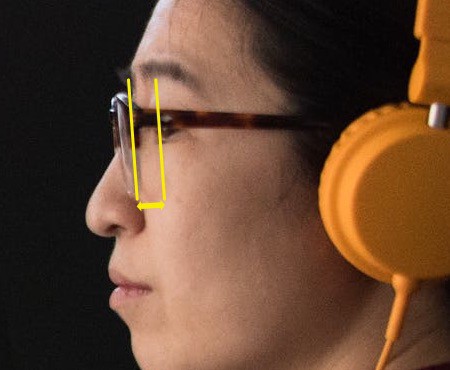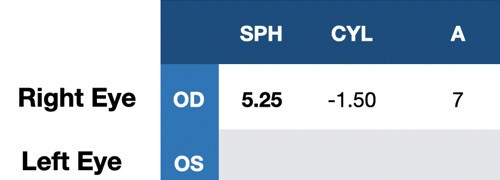In this article, you will learn how to convert your glasses prescription to contact lenses. There are a few exceptions you need to keep in mind when doing the conversation. The easiest way to convert your glasses prescription into your contact lens prescription is to use a conversion sheet I listed at the end of this article.
In this sheet, you will find three columns. The middle shows the spectacle power. This spectacle power is the same as the lens power on your prescription under the acronym SPH for the right and the left eye. When the lens power is negative you need to check what the needed prescription will be on the left of the conversion sheet.
In this case, you would be shortsighted. When you are farsighted and the lens power in your prescription is positive you need to look in the right part of the sheet to what your prescription needs to be converted.
What you need to know is such a conversion sheet uses standard parameters. The supposed distance in such a case is 12mm between your cornea and the back surface of the lens in your glasses.

While this is obviously an average your actual distance from the standard could differ a lot. And with this, the conversion needs to be calculated with a formula you find below.

When you want to use this formula you need to measure the distance between your eyes and your glasses. The unit for the distance needs to be filled in as meters. So before you are lost with this formula I will guide you through the process with an example. Let us assume you look at the prescription of your glasses and you are farsighted with a needed lens power of 5.25 diopters.

Then a person next to you need to place a ruler on the temple of your glasses and needs to measure the distance from your glasses to the back surface of the lens in your glasses. Afterward you can fill in the data in the formula and what you will calculate looks like this.

Now you successfully converted the glasses prescription to the needed contact lens prescription. But when you try to order a contact lens with 5.5029 diopters you will not find this options because in most cases the options are rounded to aquatic of a diopter. In most cases the converted prescription needs to be rounded up or down.
When you are farsighted which means you have a positive lens power in your glasses you should round down. But when you are shortsighted it might be better to round up and go for the stronger lens power. The reason for this is pretty simple your eyes are able to compensate for a slightly higher lens power easily when you are shortsighted but when the contact lens is slightly too weak in its lens power the distance will get blurry and your eyes can not compensate for that.
When you are farsighted your eyes can fairly easily compensate for a lens power that is slightly too weak but when the lens is slightly too high the distance will get blurry. The first few paragraphs focused on converting the SPH value in your prescription exclusively. However, most people will have a correction for their astigmatism in their glasses prescription. It can be found under the acronym called CYL which stands for the cylinder.
The same formula as shown for the SPH applies to the CYL value. However, the CYL value always gets combined with the A in your prescription which shows where the CYL(lens power) needs to be positioned to correct your astigmatism. While this can be problematic when converting your glasses prescription to contact lenses will be discussed in the next paragraphs.
When Converting Your Glasses Prescription to Your Contact Lenses Could Cause Problems
When you calculated the correct lens powers then the value CYL and A for Axis need to be chosen in order to be able to order contact lenses. The problem is in most cases those values also need to be rounded down or up. Presumably to the option next to the prescription. What I mean by this will get clearer when you have a closer look at the example below.

In addition to the first conversion example, we now have the CYL value and the A for the axis here. But in most cases depending on the contact lenses, you would choose the CYL value will be available in -1.25 or -1.75 diopters instead of 1.50D. my recommendation for the lower value.
With the axis things can get a little tricky even though you made no mistake during the conversion. When you look at the axis the perfect value will 7 degrees in which the contact lens should correct your vision. But in most cases only 10 and 0° (or 180°) (Which is the same in regards of the axis is available) will be an option. Go for the number which is closest to the actual prescribed axis.
Now here comes the tricky part. When the contact lens arrives only an eye care professional can see if the lens is stabilized in the optimal position. It is one thing to perform the conversion and round the values up and down but when rotation comes into play you might see blurry and think you missed something during the conversion although everything was made correctly. But the lens due to the position of the eyelids for example gets rotated in a position that has nothing to do with the 0°, 7°, or 10°.
This is why I strongly advise you to only let an optician or optometrist perform the fitting of contact lenses. Not only will you benefit health wise in the long rung when you get your check ups regularly but you will also avoid other short term problems like unstable vision or headaches.
Conversion Sheet
| Contact Lens Power if Glasses Power is Negative | Spectacle Power (Plus or Minus) | Contact Lens Power if Glasses Power is Positive |
| -3.75 | 4.00 | +4.25 |
| -4.00 | 4.25 | +4.50 |
| -4.25 | 4.50 | +4.75 |
| -4.50 | 4.75 | +5.00 |
| -4.75 | 5.00 | +5.25 |
| -5.00 | 5.25 | +5.50 |
| -5.25 | 5.50 | +5.75 |
| -5.50 | 5.75 | +6.00 |
| -5.75 | 6.00 | +6.50 |
| -5.75 | 6.25 | +6.75 |
| -6.00 | 6.50 | +7.00 |
| -6.25 | 6.75 | +7.25 |
| -6.50 | 7.00 | +7.50 |
| -6.75 | 7.25 | +8.00 |
| -7.00 | 7.50 | +8.25 |
| -7,25 | 7.75 | +8.50 |
| -7,25 | 8.00 | +8.75 |
| -7.50 | 8.25 | +9.00 |
| -7.75 | 8.50 | +9.50 |
| -8.00 | 8.75 | +9.75 |
| -8.25 | 9.00 | +10.00 |
| -8.50 | 9.25 | +10.25 |
| -8.50 | 9.50 | +10.75 |
| -8.75 | 9.75 | +11.00 |
| -9.00 | 10.00 | +11.25 |
| -9.50 | 10.50 | +12.00 |
| -9.75 | 11.00 | +12.75 |
| -10.00 | 11.50 | +13.25 |
| -10.50 | 12.00 | +14.00 |
| -11.00 | 12.50 | +14.75 |
| -11.25 | 13.00 | +15.50 |
| -11.75 | 13.50 | +16.00 |
| -12.00 | 14.00 | +16.75 |
| -12.50 | 14.50 | +17.50 |
| -12.75 | 15.00 | +18.25 |
| -13.00 | 15.50 | +19.00 |
| -13.50 | 16.00 | +19.75 |
| -13.75 | 16.50 | +20.50 |
| -14.25 | 17.00 | +21.50 |
| -14.50 | 17.50 | +22.25 |
| -14.75 | 18.00 | +23.00 |
| -15.25 | 18.50 | +23.75 |
| -15.50 | 19.00 | +24.75 |
| -16.00 | 19.50 | +25.50 |
| -16.25 | 20.00 | +26.25 |
Is a Contact Lens Prescription the Same For Glasses?
In most cases a contact lens prescription is not the same as for glasses. The reason is the reduced distance (vertex distance) between the contacts and the eyes compared to glasses. When the contact lens prescription is lower than four diopters in lens power it is more likely to be the same. However when contact lenses have a stronger lens power the prescription will not be the same.
Conclusion
Converting the prescription from glasses to contacts is not difficult. However, the results need to be looked at during a slit-lamp if the contacts position themselves optimally on the eyes. When this does not happen the whole conversion was not successful because the fit needs to be perfect for the conversion to work correctly. When the glasses’ power is lower than 4 diopters you do not need to convert the prescription. If the glasses’ power is over 4 D then use the conversion chart above or the formula to convert the prescription.
This conversion only works for soft contact lenses. With rigid gas permeable lenses other parameters need to be added in order to get a successful conversion which would make this article too long.
I wish you a great day.
